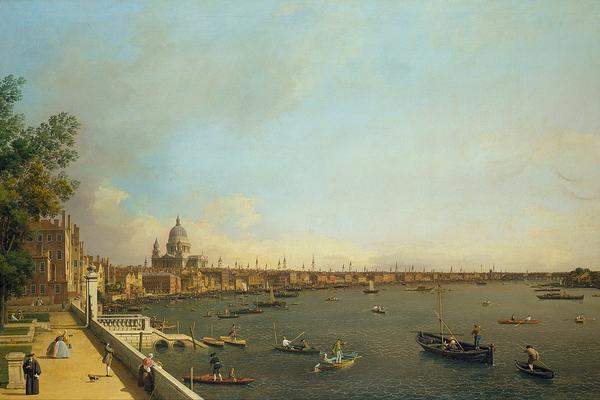As part of our series of blog posts, we will be looking at the forthcoming books which will be major outputs from the European Fiscal-Military System project.
Infinite Money: London and the European Fiscal-Military System, 1650-1870
Aaron Graham
Oxford University Press (forthcoming 2025)

Canaletto: London, the Thames from Somerset House terrace towards the City (Google Art Project)
Canaletto’s London: The Thames from Somerset House Terrace towards the City (c. 1750-1) embodies the aims of this book. The painting offers a view of London as a European city, bathed in uncharacteristic Italian sunshine and giving the impression of a Venice or a Rome suddenly and unexpectedly transferred to the banks of the Thames. In the same way, rather than analysing London as others have done as a national and imperial centre of fiscal-military state formation that looked westwards towards the Atlantic, I examine it as a European metropolis within a Continental fiscal-military system, a city that looked eastwards to Amsterdam, Hamburg, Genoa, Geneva, Vienna and other European ‘hubs’. Money, materiel and manpower flowed through London to support fiscal-military state formation and the projection of power into Europe and further afield, supplementing, complementing and even supplanting the ‘sinews of power’ in John Brewer’s British fiscal-military state.
Three key arguments lie at the heart of the book, underpinned in particular by a number of new datasets that provide for the first time accurate measures of the changing reliance of the British state upon foreign resources. The first is that after 1688 successive British ministers relied heavily upon foreign manpower, materiel and money. Foreign troops made up from 40 to 60 per cent of the total military manpower under British control before 1783, while foreign sailors plugged the gaps left by the impressment of British seamen, and foreign money supported between 10 and 20 per cent of national borrowing. Secondly, the British state was structurally dependent upon these resources. Being able to rely upon hiring troops essentially ‘off-the-shelf’, as required, enabled ministers to retain a cheap, barebones state in peacetime and ‘surge’ it in wartime while British forces mobilised. Taxes were kept low, and awkward questions about the position of Irish Catholics and other groups within the British state were avoided. Thus the British fiscal-military state, and the European fiscal-military system, were two sides of the same coin. The third is that this arrangement came under increasing strain after 1783, at precisely the moment when Brewer’s study ended. Renewed warfare cut off Dutch capital and German manpower, forcing a series of difficult political compromises as ministers tried to mobilise national resources. The British state walked backwards into autarky, and after 1815 it exported its remaining surpluses of money, material and manpower but otherwise cut its ties with what remained of the European fiscal-military system.
The book therefore reassesses London between 1530 and 1870, not merely as the site of an exercise in national state formation and resource mobilisation but also as a key node or hub in a wider fiscal-military system or network, through which European money, manpower and material ebbed and flowed. The entry of Britain into this system after 1688 made London into a major conduit for these resources, while its changed relationship after 1815 altered the nature of this relationship and eventually undermined the system and turned the British gaze away from Europe.
Aaron Graham was Research Associate for the London case study for The European Fiscal-Military System from 2019-2021 and is now Lecturer in Early Modern British Economic History at University College, London.